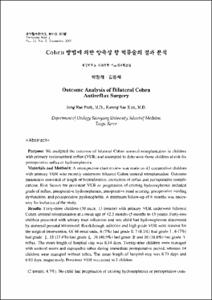Cohen 방법에 의한 양측성 항 역류술의 결과 분석
- Keimyung Author(s)
- Kim, Kwang Sae
- Department
- Dept. of Urology (비뇨의학)
- Journal Title
- Keimyung Medical Journal
- Issued Date
- 2000
- Volume
- 19
- Issue
- 2
- Abstract
- Purpose: We analyzed the
outcome of bilateral Cohen ureteral reimplantation in children with primary vesicoureteral reflux (VUR) and attempted to determine those children at risk for postoperative reflux or hydronephrosis.
Materials and Methods: A retrospective chart review was made on 43 consecutive children with primary VUR who recently underwent bilateral Cohen ureteral reimplantation. Outcome parameters consisted of length of hopitalization, correction of reflux and perioperative compli¬cations. Risk factors for persistent VUR or progression of existing hydronephrosis included grade of reflux, preoperative hydronephrosis, preoperative renal scarring, preoperative voiding dysfunction, and postoperative pyelonephritis. A minimum follow-up of 6 months was neces¬sary for inclusion of the study.
Results: Forty-three children (30 male, 13 female) with primary VUR underwent bilateral Cohen ureteral reimplantation at a mean age of 42.5 months (5 months to 13 years). Forty-two children presented with urinary tract infections and one child had hydronephrosis discovered by maternal prenatal ultrasound. Breakthrough infection and high grade VUR were reasons for the surgical intervention. Of 86 renal units, 6 (7%) had grade 0, 7 (8.1%) had grade Ⅰ, 6 (7%) had grade Ⅱ, 15 (17.4%) had grade Ⅲ, 36 (41.9%) had grade Ⅳ and 16 (18.6%) had grade Ⅴ reflux. The mean length of hospital stay was 8.14 days. Twenty-nine children were managed with ureteral stents and suprapubic tubes during immediate postoperative period, whereas 14 children were managed without tubes. The mean length of hospital stay was 8.73 days and 6.93 days, respectively. Persistent VUR was noted in 2 children
(2 ureters, 4.7%). No child had progression of existing hydronephrosis or perioperative complications. Preoperative voiding dysfunction was the only statistically significant risk factor for the persistent VUR.
Conclusions: Bilateral Cohen ureteral reimplantation is a safe and effective technique for correction of primary VUR in children. Catheterless technique may be employed for this surgery. Children with preoperative voiding dysfunction were identified as a high risk group for postoperative persistent reflux. All other children may receive little benefit from routine postoperative imaging studies.
- Alternative Title
- Outcome Analysis
of Bilateral Cohen Antireflux Surgery
- Keimyung Author(s)(Kor)
- 김광세
- Publisher
- Keimyung University School of Medicine
- Citation
- 박정래 and 김광세. (2000). Cohen 방법에 의한 양측성 항 역류술의 결과 분석. Keimyung Medical Journal, 19(2), 225–232.
- Type
- Article
- Appears in Collections:
- 2. Keimyung Medical Journal (계명의대 학술지) > 2000
1. School of Medicine (의과대학) > Dept. of Urology (비뇨의학)
- 파일 목록
-
-
Download
 19-225.pdf
기타 데이터 / 562.13 kB / Adobe PDF
19-225.pdf
기타 데이터 / 562.13 kB / Adobe PDF
-
Items in Repository are protected by copyright, with all rights reserved, unless otherwise indicated.